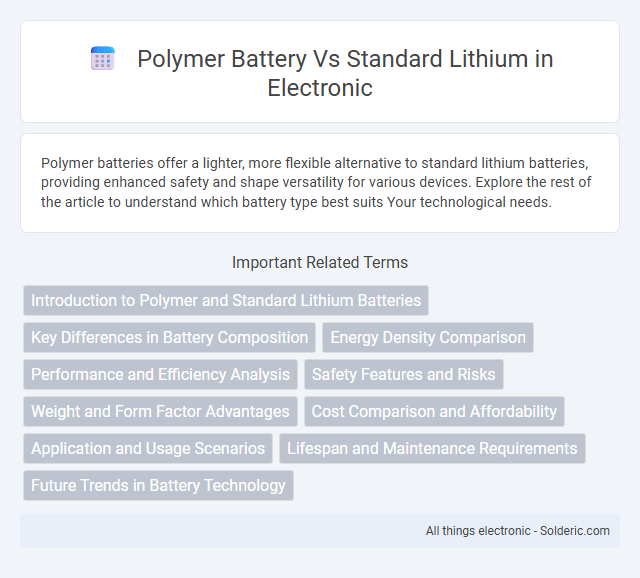Polymer batteries offer a lighter, more flexible alternative to standard lithium batteries, providing enhanced safety and shape versatility for various devices. Explore the rest of the article to understand which battery type best suits Your technological needs.
Comparison Table
| Feature | Polymer Battery | Standard Lithium Battery |
|---|---|---|
| Electrolyte Type | Solid or gel polymer electrolyte | Liquid electrolyte |
| Weight | Lighter and flexible | Heavier and rigid |
| Shape | Customizable, thin, and flexible | Fixed shape, rigid casing |
| Safety | Higher resistance to leakage and fire | Moderate risk of leakage and thermal runaway |
| Energy Density | Typically lower than standard lithium | Higher energy density |
| Cost | Generally more expensive | More affordable |
| Applications | Wearables, flexible electronics, drones | Smartphones, laptops, electric vehicles |
| Charge Cycles | Generally fewer cycles | Higher cycle life |
Introduction to Polymer and Standard Lithium Batteries
Polymer batteries, also known as lithium polymer (Li-Po) batteries, use a solid or gel-like electrolyte, offering greater design flexibility and lighter weight compared to standard lithium-ion batteries, which utilize a liquid electrolyte. Standard lithium-ion batteries are widely used in consumer electronics, providing high energy density and long cycle life but generally come with rigid, cylindrical or prismatic cells. Both battery types rely on lithium-ion chemistry for energy storage but differ in form factor, safety characteristics, and application suitability.
Key Differences in Battery Composition
Polymer batteries utilize a solid or gel-like polymer electrolyte, which enhances flexibility and safety compared to the liquid electrolyte found in standard lithium-ion batteries. The polymer electrolyte allows for thinner, lighter battery designs, often resulting in more compact and lightweight devices. Standard lithium-ion batteries typically have higher energy density but are more rigid and prone to leakage due to the liquid electrolyte.
Energy Density Comparison
Polymer batteries typically offer higher energy density compared to standard lithium-ion batteries, making them more efficient for applications requiring lightweight and compact power sources. This increased energy density allows your devices to run longer on a single charge while maintaining a slimmer form factor. Choosing a polymer battery can optimize your device's performance by balancing power capacity with design flexibility.
Performance and Efficiency Analysis
Polymer batteries typically offer higher energy density and improved charge efficiency compared to standard lithium-ion batteries, resulting in longer usage times and faster recharge cycles. Their flexible design allows for better thermal management, reducing the risk of overheating and enhancing overall battery lifespan. Understanding these performance and efficiency differences can help you choose the optimal battery type for your electronic devices or electric vehicles.
Safety Features and Risks
Polymer batteries offer enhanced safety features compared to standard lithium-ion batteries due to their solid or gel-like electrolyte, which reduces the risk of leakage and thermal runaway. Standard lithium-ion batteries commonly use liquid electrolytes that are more prone to overheating and catching fire under physical damage or improper charging. However, polymer batteries can experience swelling and capacity degradation under stress, requiring careful design to mitigate safety risks in practical applications.
Weight and Form Factor Advantages
Polymer batteries offer significant weight reduction and flexible form factors compared to standard lithium-ion batteries, making them ideal for compact, lightweight devices. Their thin, customizable shapes allow for innovative designs and better device integration without compromising capacity. You benefit from enhanced portability and ergonomic improvements when choosing polymer battery technology over conventional lithium counterparts.
Cost Comparison and Affordability
Polymer batteries typically cost more to produce than standard lithium-ion batteries due to their complex manufacturing process and flexible design materials. Standard lithium-ion batteries remain more affordable and widely used in consumer electronics and electric vehicles, making them a cost-effective choice for large-scale applications. Price differences impact product development decisions, with polymer batteries favored where form factor and weight savings justify the higher expense.
Application and Usage Scenarios
Polymer batteries are widely used in flexible, lightweight applications such as smartphones, wearable devices, and drones due to their thin profile and customizable shapes. Standard lithium-ion batteries find extensive application in electric vehicles, power tools, and large-scale energy storage systems because of their high energy density and cost-effectiveness. Both battery types demonstrate versatility, with polymer batteries excelling in compact electronics and lithium-ion batteries dominating heavy-duty energy demands.
Lifespan and Maintenance Requirements
Polymer batteries typically offer a longer lifespan compared to standard lithium-ion batteries due to their enhanced chemical stability and flexible form factor, which reduces stress on the internal cells. Maintenance requirements for polymer batteries are generally lower, as they are less prone to leakage and thermal runaway, making them safer for long-term use. Understanding these differences can help you choose the best battery type that aligns with your device's durability and upkeep needs.
Future Trends in Battery Technology
Polymer batteries are expected to dominate future energy storage solutions due to their enhanced flexibility, lightweight design, and safer chemistry compared to standard lithium-ion batteries. Innovations in solid-state electrolytes and high-capacity cathode materials are accelerating the development of polymer batteries with improved energy density and faster charging capabilities. Market projections indicate that polymer batteries will play a crucial role in powering next-generation electric vehicles, wearable devices, and grid storage systems as sustainability and performance demands increase.
Polymer battery vs Standard lithium Infographic

 solderic.com
solderic.com